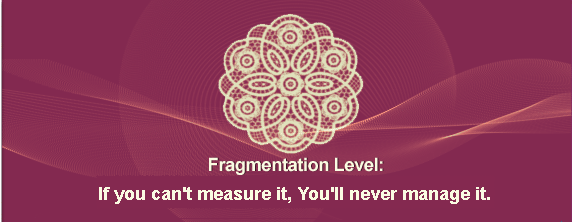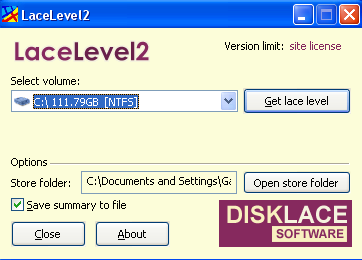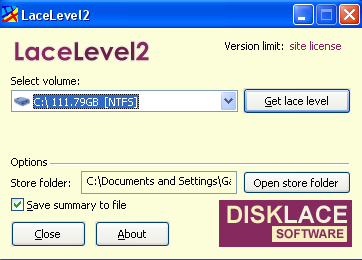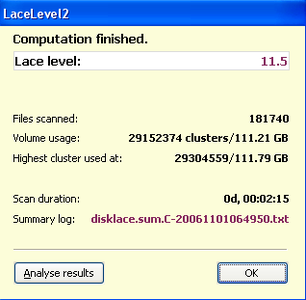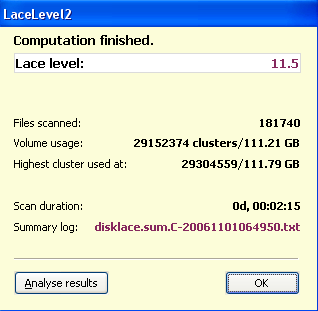Lacelevel2 v3.17 | 1.0 MB
Windows OS
Windows OS
Home Page: http://www.disklace.com/
The benefit from our technology to you:
- In moments you'll know if you have to immobilize your computer for long hours and run Defrag.
- You do not risk an unnecessary Defrag of your system, unless you really have to.
Lacelevel2 is the product in which the technology is implemented. It is also adjusted to Google's GDS and can be downloaded from their site.
LaceWatcher Enables distributed fragmentation management of all the disks (Servers, workstations, pc's) remotely by a central operator, preparing a maintenance priorities plan.
Analysis results are collected to a global fragmentation distribution chart. It is used to give an indication about the severity of your problem compared to the Industry Standard.
Pre Installation note:
The products are not integrated into the Operating system, and therefore do not cause any risk during the installation process
Future prospective
LaceDefrag will achieve the fragmentation relief at it's first stages of operation (see graph) . Register to get availability notice.
Support of future trends in the storage world and more data systems
Fragmentation and Lacelevel
Fragmentation means that the data in the storage device(s) are not concentrated in stable, adjacent units, but are split among various locations
Lacelevel is the measure created by Disklace LTD to enable calculation of the quality of the storage device affected by the level of fragmentation.
Why is it necessary to measure fragmentation level?
Simply put, the higher the Lacelevel measured on a disk, the slower the computer will work. When the data on the disk is heavily fragmented, the computer has more work to do to locate the data components, and the result is a general slowdown of the machine.
What happens if you don't measure it?
When your disk reaches levels that Lacelevel would have considered high, conventional tools, such as Defrag, will not improve the computer’s running much. Lacelevel warns you long in advance and let you organize your data in an optimal fashion.
Performing maintenance activity not only takes time, but has also been found to be the most dangerous activity for any disk. Running Defrag too often increases the risk of damage to the disk due to technical error. If this happens, the user is forced to recover and install the data from a backup, if it exists. Lacelevel constantly monitors the quality of the data in the storage device and prevents its deterioration.
Other fragmentation estimation methods
There are several methods for determining the quality of data on the disk. All give an incomplete view.
The early methods are still in use in some of the popular operating systems even today. These work by measuring the percentage of fragmented files from all the files on the disk, resulting an unreliable picture as the number of the fragments does not characterize the fragmentation level.
Another commonly used method is disk mapping, which pretends to give the user a true picture of the fragmented areas on the disk. But presenting the status of the disk in this way is misleading. Every point in the chart gives only the average situation of the described area, and increasing the chart resolution would display a different situation. With such a limited method, users cannot make informed decisions.
Calculating Lacelevel
Lacelevel is a statistical scalar factor, calibrated by results of measurements of many thousands of real disks of different types from users all over the world. The method that calculates this factor is patent pending for all countries.
The factor data is collected from the physical position of the various file components on the disk. It also takes into account the distribution of free areas on the disk. This distribution best describes the way the particular computer is being used. The “holes” between the files are made by the deletion of old data on the disk, and therefore reflect the real pattern of that disk.
A statistical moment factor is calculated for all the elements that cause a delay while reading or writing a file. This is then compared to an ideal theoretical disk containing the same data as the analyzed disk. The result is shown on a logarithmic scale, similar to the method used in measuring earthquakes on the Richter scale.
Analyzing the results
After analyzing the disk and receiving the Lacelevel, the user is given an opportunity for deeper analysis of the results. Our accumulated statistical data base is made available so that you can compare the condition of your disk to the global fragmentation distribution.
Many users run Defrag after seeing their results on Lacelevel, and then check the Lacelevel again to see the improvement caused by Defrag. The improvement is defined as the difference between the first check and the one after the Defrag. . We have results of several thousand such tests, and we can Show that difference between the measurements.
Please note that the measurements of Lacelevel are exponential, so a decrease of 1 unit before and after Defrag means an improvement of x10.
From the chart it is clear that in most cases the improvement of Defrag to the fragmentation level was of up two Lacelevel units only. This proves our claim that delaying Defrag beyond a certain point brings your disk to an unrecoverable situation.
We do not show the distribution we got for disks in which Lacelevel actually increased between measurements, because we cannot distinguish between the samples of normal daily use which increase fragmentation and those caused by massive disk cleanup not followed by Defrag. In the latter case, the number and size of empty spaces increases, and so does the Lacelevel



